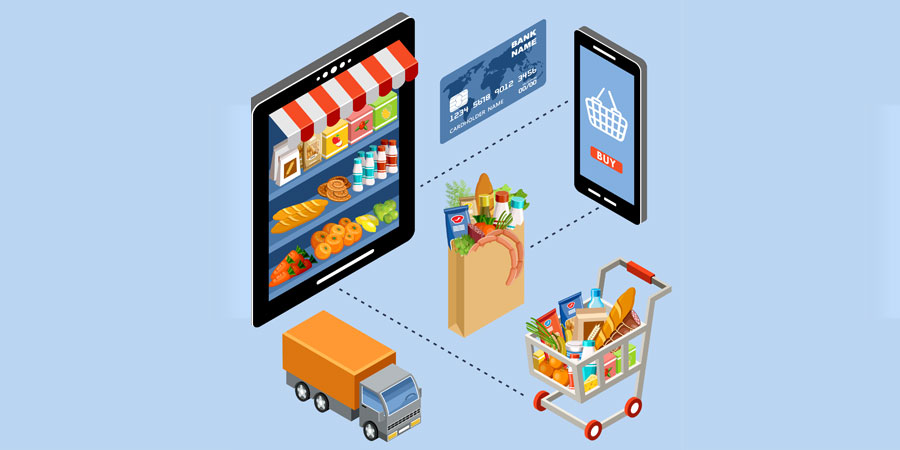
Reliance Jio Mart app returns 1,37,00,000 results in 0.76 seconds when searched on Google! Launched only a few months ago, this app has caused major disruptions in FMCG trade dynamics. This sector is one of the world’s most competitive industries. To stay ahead, companies are always searching for ways to boost efficiencies and reduce costs, often through investments in technology.
How Technology is Improving Efficiency in the FMCG and Retail industry?
Technology can be leveraged to boost efficiency within the FMCG sector. Some of the ways technology helps increase efficiency include:
Automation of Production Processes: Technology has automated many production steps, from packaging to labeling. This saves time and eliminates the need for manual labor, ultimately leading to cost savings.
Better Inventory Management: Companies are utilizing technology to better manage their inventories. This includes using RFID tags for inventory levels and location tracking as well as predictive analytics to anticipate future demand.
Improved Logistics and Transportation: Technology is being employed to enhance the product logistics and delivery. This includes GPS tracking for optimizing delivery routes as well as using drones or robots for last-mile delivery.
Enhancing Customer Service: Technology is being employed to enhance customer service in this sector. This includes using chatbots and artificial intelligence for quick and efficient support. Create more tailored marketing campaigns by utilizing data analytics to gain insight into customer preferences and target them with relevant ads and offers.
eCommerce is disrupting the FMCG industry
eCommerce has had a profound effect on the sector. In the past, most FMCG companies distributed their goods through physical stores; however, with the growth of eCommerce, more and more consumers are purchasing FMCG items online.
This has caused several changes within the industry, such as:
Shifting Marketing Strategy: Companies are altering their tactics to reach consumers buying FMCG products online. They now prioritize creating more personalized and targeted campaigns.
Increased Competition: The eCommerce landscape is highly competitive. To stay ahead, FMCG companies must invest in eCommerce and digital marketing strategies.
Supply chain complexity has increased: The eCommerce landscape has dramatically transformed FMCG supply chains. To stay relevant in today’s digital marketplace, companies are investing in advanced technologies like warehousing and fulfillment solutions to better cater to online consumers’ demands.
Consumer Profile Shift: Online shoppers for FMCG products tend to be younger, better educated, and have higher incomes compared to those who shop in physical stores.
Technology as an Aid to FMCG Transformation
As the FMCG sector continues to be disrupted by eCommerce, technology will play a vital role in helping companies transform their businesses.
Digital Marketing
FMCG companies need to invest in digital marketing to reach the new generation of online consumers. This involves investing in SEO, social media marketing, and online advertising.
Blockchain
Blockchain technology can assist FMCG companies in creating a more transparent and efficient supply chain. This will enable them to monitor goods from farm to table and guarantee that products are secure and of high quality.
AI and data analytics
Artificial intelligence (AI) and data analytics can assist FMCG companies in better comprehending their customers. This allows them to craft more tailored, precise marketing campaigns.
Internet of Things (IoT)
Utilizing IoT technology allows FMCG companies to monitor product movement and manage inventory more efficiently, helping them reduce costs while improving customer service levels.
Big Data
Big data provides FMCG companies with valuable insight into consumer preferences and trends, allowing them to make better product development, marketing, and sales decisions.
What factors are driving digital adoption in the consumer goods segment?
Factors driving digital adoption in consumer goods manufacturing include:
The Growth of eCommerce: The rise of eCommerce has had a profound effect on the FMCG industry. Previously, most FMCG companies distributed their goods through physical stores; however, with the rise of eCommerce, more consumers are now purchasing FMCG items online. This has caused several changes within this sector, such as:
An increase in direct-to-consumer sales: Many FMCG companies now sell their products directly to customers through their eCommerce websites, bypassing traditional retailers and offering their items at lower prices.
A Shift to Digital Marketing: With more consumers buying FMCG products online, companies are allocating more of their marketing budgets towards digital channels such as SEO, social media marketing, and online advertising.
Companies Are Shifting Their Marketing Approach: Companies are altering their tactics to reach consumers who buy FMCG products online. Now they prioritize creating more personalized and targeted campaigns.
What Challenges Will Businesses Face as They Go Digital?
FMCG companies face numerous obstacles as they venture down the digital path. These include:
The need to invest in technology: FMCG businesses must invest in cutting-edge tools like warehousing and fulfillment solutions to remain competitive on the eCommerce landscape.
FMCG Companies Must Alter Their Business Model: Many FMCG companies must alter their business models to succeed in the eCommerce space. This involves transitioning away from product-based operations into platform-based ones.
Investment in Digital Marketing: Companies must allocate resources to digital marketing to reach consumers who purchase FMCG products online. This includes investing in SEO, social media marketing, and online advertising.
FMCG companies must create an unbeatable omnichannel experience for their customers to remain competitive in today’s eCommerce landscape. This involves offering a consistent experience across all channels, such as physical stores, websites, and mobile applications.
How are FMCG companies using technology to create an engaging user experience?
FMCG companies employ various technologies to deliver a distinctive user encounter. These may include:
Virtual Reality: Virtual reality provides consumers with a realistic preview of products before they purchase them, particularly in the food and beverage industries where consumers want to see how the item looks before making a purchase.
Augmented reality: Augmented reality can give consumers more information about products. This is especially beneficial when it comes to cosmetics, where people want to see how the item will look on them before making a purchase.
Chatbots: Chatbots can offer customer support and answer questions about products. This can be especially beneficial to consumers who need more details before buying something.
Some of the technology trends in retail and FMCG include:
Utilization of Machine Learning for Forecasting Customer Demand: With Machine Learning and available data, forecasting customer demands becomes more accurate and easier. Demand forecasting assists in planning inventory, and managing manufacturing, and marketing processes. Furthermore, the implementation of ML is fast; it handles big data quickly with accurate predictions, thus preventing overstocking, warehousing, and logistics expenses for businesses.
Virtual fitting rooms may seem impossible, but according to predictions by a market research company, augmented reality is on the rise. This ‘try-and-buy approach’ allows consumers to try on an outfit and specs through augmented reality for an in-store experience before they buy it, giving buyers an invaluable in-store feel. With people being forced to shop from home due to the pandemic crisis, this trend has gained even greater acceptance.
RFID tags, computer vision systems, IoT devices, machine learning, and facial recognition all contribute to providing contactless and cashless buying experiences. A leading retail store has implemented computer vision and sensor fusion technologies that enable buyers to add items to their cart while the sensors automatically detect value and generate a bill amount.
Advertising and Commerce: Technology is playing an increasingly important role, not just from the consumer’s standpoint but also in marketing services. Alexa and Siri are two popular voice assistants that assist with voice assistance and commerce. Artificial intelligence can capture keywords and suggest relevant products using machine learning, giving a major boost to marketing efforts.
Driverless cart services for grocery delivery, autonomous delivery trucks, and drone deliveries are being tested and implemented around the world. Furthermore, robotics in customer service and healthcare has seen a meteoric rise.
These trends are here to stay and will continue to expand. Businesses must take advantage of all that technology has to offer to maximize their growth potential. Stay tuned to get more such great content.
